|
< Earlier Kibitzing · PAGE 2 OF 2 ·
Later Kibitzing> |
Jan-23-24
 | | KEG: A remarkable endgame performance by Smyslov. Triple-minor piece endgames are unusual and highly difficult making Smyslov's superb handling of this finale all the more superlative. This game was Smyslov's final appearance in the Dutch portion of this championship. In the eight games he played during the two Dutch lap Smyslov drew his four games against Reshevsky and Botvinnik and lost both games against Keres. He remained in the hunt for second place only by winning both games against Euwe (including this one). Euwe had a disastrous first lap in Holland, losing all four games. In this second lap, he did much better; drawing three games. But he lost both games against Smyslov. His loss here, as a practical matter, ended any prospect of getting a decent score. His chances of winning the tournament were already gone even before the instant game. 1. e4 e5
2. Nf3 Nc6
3. Bb5 a6
4. Ba4 Nf6
5. 0-0 Be7
As pointed out by many commentators (e.g., Keres and Kmoch), going into this event Euwe was known to favor the Open Ruy Lopez (5...Nxe4). Two rounds earlier, however, he tried 5...Be7 against Keres, got a good game and even had winning chances as Black. So here against Smyslov in Round 9 he tried the same move--one with which Smyslov had considerable experience. 6. Re1 b5
7. Bb3 d6
Declining to try the Marshall gambit (7...0-0 and then 8...d5). 8. c3 Na5
8...0-0 is more usual, but Euwe had a new idea in mind for this game. As will be seen the line Euwe employed is a mixed bag, but entirely sound. 9. Bc2 c5

click for larger view10. d4
The one problem with Euwe's line--as nearly pointed out by Keres--is that White need no longer lose time with h3 (which White typically plays in the closed Ruy) because if no 10...Bg4 White can play 11. bxe5 BxN 12. QxB dxe5 13. Qg3 winning a pawn. The above being said, Black is still doing fine with Euwe's line. 10... Qc7
11. Nbd2
Keres called 11. a4 "very strong." But after 11...c4 (instead of 11...b4, the only move Keres considered) Black still looks quite fine to me. Golombek recommended 11. h3, but that seems to give Euwe everything he wanted with 11...0-0 with approximately equal chances. 
click for larger view11... Bb7
This was Euwe's idea in employing this line. But b7 look like a poor square for this Bishop. Indeed, looking ahead to the minor piece ending, this Bishop becomes horrendously weak on the Queen-side. It would be silly to overstate the downside of this move, but it is hard to ignore what ultimately befell Euwe down the line here. All in all, Golombek's 11...cxd4 looks best, with Kmoch's 11...0-0 a close second. 12. Nf1
Stockfish likes 12. d5, but that looks too committal. Keres prefers 12. cxd5, but as Euwe points out that packs little punch here. The text, a typical ploy by White in the Ruy Lopez, appears entirely reasonable, and left the position as: 
click for larger viewThis all looks like the beginning of the sorts of plans one sees with the closed Ruy Lopez. Euwe soon got into trouble, but thus far this game was an interesting opening battle. |
|
Jan-24-24
 | | KEG: Post II
12... cxd4
Castling was perhaps simple, but the text--even if not best here--is typical play by Black in such Ruy Lopez positions. As we will see shortly, however, Euwe had a reason to postpone castling. 13. cxd4 Rc8
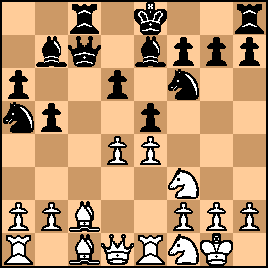
click for larger view14. Re2
If now 14. Ne3, Black--having not castled--can play 14...Nxe4 (which, as Euwe pointed out, now does not run into 15. Nf5). This does not mean that 14. Ne3 would have been a mistake, just that White has reasons to explore other options. The text does appear "cumbersome" (Golombek's description), but it is hard to find anything significantly better. If 14. Bd3 (the computer move) Black is fine after 14...exd4 (probably superior to Golombek's recommended 14...Nc6). 14... 0-0
Having delayed castling, Euwe should perhaps have considered 14...Nc6, seeking a better post for the awkwardly placed horsie. The above being said, Black's position remains entirely viable, and Euwe was probably entirely satisfied with his new venture against the Ruy Lopez. 15. Ng3
The rote strategy for White in the Ruy Lopez. Smyslov here might have considered closing the position with 15. d5. After the text, White's edge, if any, was miniscule: 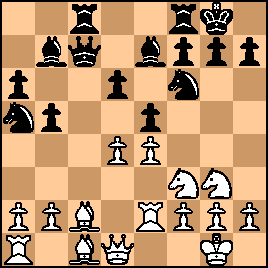
click for larger view15... Rfe8
Euwe called 15...g6 "worth considering.'' He assumed, however, that White would play 16. Bh6 in response, but--as Golombek noted--Black then easily equalizes with 16...Rfe8. Golombek, however, over-rated Black's resulting position, considering only 17. Rc1 Ng4 when Smyslov might have played the far superior 17. d5. Nonetheless, 15...g6--despite weakening the black king-side squares--was likely best. The text, however, worked brilliantly since Smyslov missed what was probably the best continuation: 16. b3
Keres praised the idea of developing the ca Bishop on b2, and Golombek gave the move an "!" But, as discussed below, the text only seems to have worked because of Euwe's weak response. The best idea still seems to lock Black up tight with 16. d5. Another plan for White would have been to play 16. Nf5 here. Euwe trashed this notion in his commentary on the game, but his analysis looks suspect. If 16. Nf5 Bf8 (Euwe's suggestion, which appears reasonable to me) then not Euwe's 17. Bg5 after which Black gets the edge with 17...Nh5 [better than Euwe's 17...Nd7] but 17. d5 after which White seems to enjoy a small edge. But the above notions soon all became moot when Euwe, instead of 16...exd4 or 16...Nc6 (both of which yield about equal chances for Black) chose to play: 16... Bf8?

click for larger viewNow Smyslov could have seized the initiative with either 17. Bg5 or 17, d5. Instead, he persisted with his doubtful idea to post his dark-square Bishop on b2: 17. Bb2

click for larger viewEuwe seemed to have dodged a bullet, and the game lumbered on in its closed features. The great excitement in this game still lay far ahead. |
|
Jan-25-24
 | | KEG: Post III
17... g6
Golombek praised this move (on which he said Euwe spent 35 minutes) since it "puts paid to White's hopes for an attack on the King's side (by Nf5, h6, g4). But I find Keres' assessment more convincing: "This move is not bad, but it is not necessary at the moment as White was not yet threatening Nf5. It was more important for Black to bring his knight on a5 back into the game by playing 17...Nc6 with the intention of eventually directing this knight towards the f4-square." Keres went on to call 17...g6 "...one of the reasons behind Black's subsequent difficulties." The other problem with the text is that it yet again affords White time to place a vise on the position with 18. d5. For some reason, Smyslov repeatedly ignored this possibility until move 22, and Euwe made no effort to preclude it (with, e.g., exd4). Since both Smyslov and Euwe ignored d5 here and until move 22 and no mention of d5 appears in any of the commentaries by world-class players, I must be missing something. But what? 18. Qd2
Keres stressed the need to avoid Bh6 by Black, while making no mention of the virtues of 18. d5. 18... Bg7
If Euwe feared 19. d5, he would probably have played 18...Nc6 or perhaps just trade off the White d-pawn with 18...exd4. 19. Rc1
Yet again shunning the chance to play d5.
19... Nd7
Keres here remarks on Euwe's continued reluctance to play the seemingly indicated 19...Nc6, noting that this failure was perhaps of minimal significance in such a closed position. Euwe could also, of course, have precluded d5 with 19...exd4. Smyslov 1:15
Euwe: 1:16
20. R2e1
Here we go again. Smyslov still delays d5
The text left:

click for larger view20... Nc6
Finally! But 20...exd4 to get rid of the pesky White d-pawn still looks good. If instead 20...Qb6 White would get the better game with 21. d5, as Golombek noted..(So glad somebody else was thinking about playing d5). 21. Bb1
Still no d5. I am perplexed.
21... Qb6
This was Euwe's last chance to avoid d5 with 21...exd4. Euwe later said that he played the text "to force White to show his hand in the center." Be careful what you wish for:
22. d5
At long last!
"!"--(Euwe)
Somewhat less charitably, Keres said that the text would sooner or later be forced, and claimed that now that 22. d5 had been played:"...the draw should sooner or later be an unavoidable result, unless either side wants to take some risky winning attempt." I worry about going head-to-head with Keres, but doesn't White have far more space after the text? 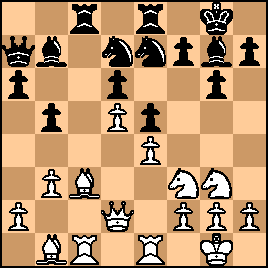
click for larger viewI fail to see why Smyslov should be thinking about playing for a draw at this point. 22... Ne7
23. Bc3
"!"--(Keres)(Golombek)(<plang>) 
click for larger view"Preventing ...b4 as well as a5, whereby Black could have generated counterplay on the queenside." (Keres) "A beautiful blockading move, designed to render Black's Q Bishop null and void...Already the constriction in the Black position i becomin noticeable..." (Golombek) |
|
Jan-27-24
 | | KEG: Post IV
23... Ba8
Golombek purported to provide a justification for this weird-looking move: "A semi-waiting move that clears the line of retreat for Black's Queen, has remote designs on forcing b4 by Rb8, and also conceals a small trap." But a more salient assessment was given by Kmoch: "...An early draw might be anticipated if...well, if the Black Queen Bishop didn't spoil the picture. This unhappy piece has sunk even deeper in the mud as it retired to prepare for the Queen's retreat to b8..." Kmoch went on to recommend 23...Qa7, but that would hardly ease Black's woes. Euwe's position at this point was almost certainly not theoretically losing. But his situation was hardly cause for cheer. All he could do was exercise Petrosian-like patience. In any case, whatever the theoretical assessment, Smyslov now had the onus of trying to capitalize on his edge. Smyslov lost now time: 24. h4
"!"--(Kmoch)
Golombek and Euwe claimed that 24. Ba5 would have been refuted by 24...Bh6. But this would have been a blunder by Black since Smyslov could then simply have played 25. QxB QxB 26. Nf5 since then 26...gxN would run into 27. Ng5 Nf8 28. Qf6. After 24. h4, the position was:
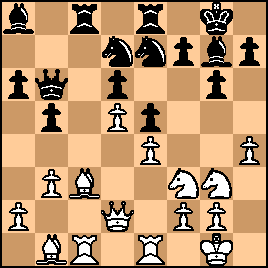
click for larger view24... h5
This obviously creates serious weaknesses for Black, but I see nothing better. Keres' suggestion of 24...Nf6 leaves Black with little or nothing after 25. Ba5. The best overall view of the text I have seen is that of Kmoch: "Not only to prevent 25. h5 but also preparing for a possible ...Bh6. Although this works well in the middle game since White cannot very well hold his pressure on the c-file, the advanced Pawn constitutes an endgame weakness." The clocks, according to Kmoch, now read:
Smyslov: 1:42
Euwe: 1:43
25. Ba5 Qb8
As pointed out by Euwe and <plang>, 25...Bh6 here would get crushed by 26. QxB QxB 27. Ng5 [the move given by <plang> which is far superior to Euwe's suggested 27. Nxh5] Nf8 and now 28. Nf5 [better than plang's 28. Nxh5] 26. Nf1
"White's only attacking idea in this position is a subsequent transfer of the knight to the b4-square." (Keres) The position after the text was:

click for larger view26... RxR
Keres thought this was helping White's plans and recommended 26...Nf6. But then White can continue with 27. Ng5 followed by Ne3 and Nc2. Euwe's move looks like the best defense to me (though hardly a panacea for wll of Black's woes) 27. RxR Rc8
28. Ne1
Consistent but slower than necessary. 28. Ng5 or 28. Rc2 look more direct. The text left:

click for larger view28... Nc5
"Intending to drive out the Bishop by Nb7." (Golombek) "...to prevent Nd3 and Nb4." (Kmoch)
Smyslov: 2:02
Euwe: 1:59
29. Qg5 Kf8
30. Qe3 Ng8
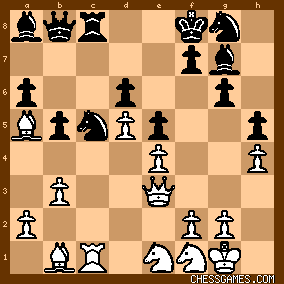
click for larger view |
|
Jan-27-24
 | | KEG: Post V
Thus far, the game had proceeded in almost slow motion. Euwe's position was cramped and wretched-looking. But how if at all could Smyslov capitalize? 31. Qh3
Golombek liked this move, considering it a good retort to Black's threat of 31...Bh6. Kmoch gave bizarre analysis in support of his preference for 31. b4 (which loses outright to 31...Bh6)..Kmoch must have had the wrong position on his board. Golombek, by contrast, provided a good overview of where matters stood: "The trouble about Black's game us that, owing to the miserable position of his (c8) Bishop, he has neither future prospects nor present activity, whilst White, serene in the command of most of the board, can work out his plan of campaign at leisure." I favor the plodding 31. Nf3, with Rc2 and Qe2 in view followed by b4. 31... Bh6
Black's only counter-play, but after White's lethargic 31st move, it leaves Black with reasonable chances of survival if he can remain patient and keep his head. 32. Rc3 Ne7
"The knight is not standing well on e7 and it was therefore a pity to move it back to this square. 32...Bb7 followed by Nf6 looks simpler." (Keres) While I prefer 32...Nf6, I particularly like Keres' overall assessment at this point: "...the position is so meager of possibilities that both sides have a wide variety of waiting maneuvers at their disposal that do not significantly chance the equilibrium of the position." 33. Bc2?
Cribbing Keres' view, White has a number of plausible ways to proceed here (33. Bb4; 33. Nf3l 33, Ne3), none of which provides any immediate winning lines. The text, though not noticed by any of the commentators, was a mistake that allowed a tactical trick that likely would have led to a draw for Black, the position currently being: 
click for larger viewBlack to play and draw.
33... Nb7?
Missing his chance. The tactical trick (which I missed too but which Fritz and Stockfish spotted instantly) is 33...Bxd5 34. exB Nxd5 35. Rf3 (White could get into serious difficulties after 35. Rg3 Nf4 36. Qh2 Ne2+ 37. Kh1 NxR+ 38. QxN b4 leaving Black with Rook plus two pawns for two minor pieces plus the clear initiative) 35...Nf4 36. RxN (White has nothing better) BxR with about equal chances. I would bet that Bobby Fischer or Magnus Carlsen would have found the drawing line in about a nano-second, as would many other elite players (and some no-elite ones too). Keres said that, with his actual move, Euwe lost patience. Perhaps, but Keres' suggested 33. Ke8 is not much of an improvement on Euwe's move. 34. RxR+
Here, in my view, Smyslov lost patience. With 34. Bb6, he had decent prospects of maintaining his grip on Black's position. The text left:

click for larger view34... QxR
Golombek thought it a mistake to allow Smyslov to trade Queens and suggested 34. NxQ. In fact, White has a small edge in either case, but not anything that looks close to a winning advantage. 35. QxQ+ NxQ

click for larger viewGolombek thought this 8 minor-piece ending [how often do we see that!] very much favored White: "...White enjoys two advantages: (1) two Bishop; (2) command of greater space, especially when the unfortunate black Q Bishop is taken into account." Euwe and Keres disagreed:
"Black...has reached an equal endgame, albeit one with a few finesses." (Euwe) "An endgame has now occurred where a quick draw can be expected." (Keres) All of these commentators over-state their views. White is clearly better, but Black with careful play need not lose. So how did Smyslov prevail in this game. Golombek thought he won because he exploited his advantages: "Smyslov's handling of [his] advantages is most instructive and masterly." Keres, by contrast, thought that Euwe blundered away his chances: "It is surprising to observe how fact Black is able to place himself in a lost position." The truth in my view lies somewhere between the respective comments by Golombek and Keres, as I will attempt to show in my upcoming posts on this game. |
|
Jan-29-24
 | | KEG: Post VI
36. Bc3 Nc5
Kmoch liked this move. User <DouglasGomes> thinks that 36...Nb6, putting pressure on d5, was a superior way to play for a draw. I see little to choose between the two moves. In either case, Black suffers from his horrendouc a8 Bishop but does not appear to be in any immediate jeopardy. 37. Bb4 Ke7
"?"--(Golombek)
Golombek prefers 37...Nb6 followed by 38...Nd7. As with the debate about Euwe's prior move, I see little to choose between the move played and the one suggested. 38. f3
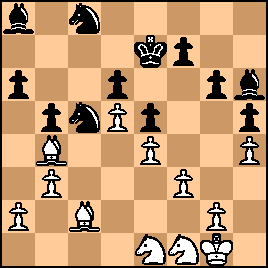
click for larger view38... Kd7
"?"--(Golombek)(Euwe)(Keres)
Everybody is down on Euwe for this move. Euwe went so far as to call it the "probably the decisive error." And everybody prefers 38...Nb6. I too prefer 38...Nb6, but the rest of the commentary here strikes me as over the top. 38...Nb6 would still have left Euwe with a difficult position, and he was not close to losing after the text. The real drama in this game still la ahead.
39. Nd3
Keres extols the text because it supposedly eliminates Black's c5 knight. Perhaps But this hardly brings White close to winning. A better try is 39. g4 with--after 39...hxg4 40. fxg4 a view to 41. g5. Moreover, as will be seen, Euwe need not have allowed the Knight trade. 39... NxN
Black could also have played 39...Nb7. This leads to more cramping, but it avoids trading off what is arguably Black's strongest piece (though, admittedly, it wouldn't be so strong after my suggestion). 40. BxN

click for larger view40... Ne7?
Nobody raises a peep about this move, though--as Keres notes--the idea behind it of playing f5 is easily prevented. Best for Black here is to remain patient and force White to try to press for something tangible. My choice for this is 40...Bb7. The text leaves, 
click for larger viewNotably, it is only here that Smyslov's analysis of the game begins. He gave the following overall view of the position at this point: "...White's pieces are much more active, especially if the unfortunate position of the black bishop at a8 is taken into account. But it is difficult to gain an advantage from this factor as there are no serious weaknesses in Black's pawn formation, and his pieces can be transferred to better position." That, in my view, pretty much says it all (though I still dislike 40...Ne7). 41. g4
"!"--(Kmoch)(Golombek)(Euwe)(Keres) (Smyslov)
"Breaking open the position on the King's side, and so giving his two Bishops more scope" (Golomnek) "The long-awaited breakthrough comes as something of a defensive measure to prevent 41...f5" (Kmoch) "At precisely the right moment." (Euwe)
"Now White is threatening the capture on h5 followed by Ng3, or even g5, @#$%ting the dark-square Bishop out of the game." (Smyslov) Keres, whose view on the text I share, said that it's primary purpose was to avoid f5 by Black, and went on--correctly in my view--to caution that, at best, the text required Euwe not "to defend himself very accurately." It may be heresy (in light of the above comments) but I think the text worked only because Euwe now began to fall apart. I prefer 41. a4. The text, by contrast, gave Euwe good chances for counter-play, as I will try to show in my next post on this game. In any case, the text left:

click for larger view |
|
Jan-31-24
 | | KEG: Post VII
41... hxg4
"?"--(Keres)
The merits of this exchange has been much debated. Kmoch called it "forced."
Golombeck said everything else was bad.
Keres called the move "a mistake," saying that "Black eliminates White's worthless pawn on f3 and later gives him the possibility to break through on the kingside." The most sober view of the move was that given by Smyslov: "This exchange was not essential, and makes it easier for White to take the initiative on the kingside." The real issue in my opinion is not whether the text is good (since Black remains in bad shape after this exchange); but whether there was anything markedly better. The main alternative discussed by the commentators, and the move Keres called "necessary," was 41...Bf4. Kmoch, who considers the move futile, only considered in response 42. gxh5 which allow Black good chances to survive after 42...gxh5 43. a4 [Kmoch's 43. Kg2, although he analyzes this as a win for White is absurd and leads to a draw after 43...Ng6 44. Kh3 and now 44...Bc1 instead of Kmoch's 44...Bb7, and if indeed 44...Bc1 45. Ng3 BxN [45...Bc8 is much better than Kmoch's move] 46. KxB and now 46...f5 and not Kmoch's losing 46...Bc8? Golombeck' 42. Kg2 in this line may actually LOSE for White after 42...hxg4 43. fxg4 f5!. The real issue after 41...Bf4 is the move considered by Keres and Smyslov: 42. g5! But Keres then says that "the kingside will be closed once and for all and Black should not have any difficulties obtaining a draw." But Smyslov seems to have looked deeper still into the position and gives the following line after 42. g5: 42...Nc8 [perhaps 42...Bc1 is slightly preferable, but White is still clearly better] 43. Ba5 Bc1 44. a4 bxa4 45. bxa4 Bb7 46. Kg2 leaving White with reasonable winning chances. In Smyslov's line, the superior move in my (Fritz-aided) view is 43. a4 (43...bxa4 44. bxa4 Bb7 [pretty much forced] 45. a5 leaving Black practically paralyzed. As is obvious, the analysis in the event of 41...Bf4 is very difficult. Anyway, let's at long last return to the actual game after Euwe's 41...hxg4 42. fxg4
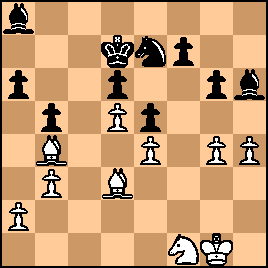
click for larger view42... Bc1
"!"--(Smyslov)
"?"--(Kmoch)
More controversy.
Kmoch said that, after the text, Black's position "deteriorates." Instead, he opted for 42...f5. But he only considered 43. exg5 which is obviously inferior, and overlooked the far superior 43. g5! analyzed by Smyslov and Keres which looks dreadful for Black. The key question here involves the merits of 42...Bf4 which was analyzed by Smyslov and Keres. Smyslov called this line "dubious for White because he, unlike Keres, considered after 43. g5 the key move 43...Nc8 which may indeed give Black drawing chances, while Keres' 43...Ng8 runs into major trouble after 44. a4. Turning once again to the actual game, the position after Euwe's 42...Bc1 was: 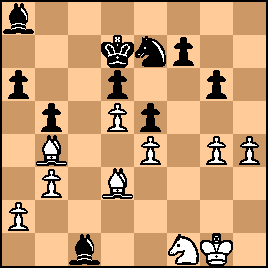
click for larger viewNow came another of the key moments in this terribly complex endings. How should White proceed? |
|
Feb-01-24
 | | KEG: Post VIII
43. g5
"!"--(Kmoch)(Euwe)
"Now that [f5] is permanently prevented, Black's only possible counter-chance disappears." (Golombek) "Very strong. With Black's Bishop Pawn restricted, White has ample time to regroup his pieces." (Kmoch) "Black was now threatening to play ...f5, hence this move is almost forced. White,,,deprives Black of all counter-chances. Additionally, as Golombek pointed out, 43. h5 would be bad (and dissipate White's edge after 43...gxh5 44. gxh5 f5! But there was a fly in the ointment overlooked by all the commentators. For one thing, White could have solidified his advantage with 43. Nd2, since if then 43...f5 White simply proceeds with 44. h5 and then after 44...gxh5 has a probable win with 45. gxh5. But there was a more serious flaw with the much praised 43. g5. It left the position as: 
click for larger viewBlack to play and draw.
The saving move, overlooked by everybody (except for the computers) was 43...Bxd5! Play might then proceed 44. exB Nxd5 45. Be1 (best) Nf4 45. Bc2 d5 leaving Black with two passed center pawns for the sacrificed piece and ample counter-play. Needless to say, finding this over the board would not have been easy. Kmoch did consider 43...Nxd5 but after 44. exN Bxd5 White retains strong winning chances with 45. Ng3 Kmoch's move, however, was far superior to Euwe's actual choice: 43... Bb7
44. Kf2

click for larger view44... Nc8
"?"--(Keres)
The text does look look wretched and holds scant hope for survival, but there does not appear to be anything significantly better. Keres suggested the even more dreadful looking 44...Ng8 with the idea of a forthcoming f6. But Smyslov later dashed this notion, giving 45. Ng3 f6 46. Ne3 Bb2 (pretty much forced). White then does indeed have a win by pursuing the Black Bishop on b2, but only with the problem-like 47. Ke1 [and not with Smyslov's sloppy 47. Ke3 which would run into 47...f5! 48. exf5 Ne7! 49. fxg6 Nxd5+ 50. Kd2 NxB 51. g7 Bd5 52. Bh7 e4 53. g8(Q) BxQ 54. BxB d5 with a wild continuation in view (e.g. 55. h5 d4 56. a3 Nd3 57. g6 Nf2 58. Nf4 (best and the only winning chance) d3 59. h6 e3+ 60. Kxe3 Ng4+ 61. Kxd3 Nxh6 62. Bh7 Bxh3 and it is hard to see how White can win]. Sorry for the long line. But clearly 44...Ng8 would not have saved the day with best play by White. In sum, I see nothing better than Euwe's 44...Nc8 45. Ne3

click for larger viewThe situation remains complex, and the climax of the game was approaching. |
|
Feb-03-24
 | | KEG: Post IX
45... Ke7
"Now the maneuver 45...Ne7 folowed by ...Ng8 is already too late, because in the meantime White can transfer his Knight to g4 and thus prevent f6." (Keres) Indeed, I see no saving move for Black here. I had considered 45...BxN+ followed by a waiting game, but White will soon enough get in Ba5, h5, and then g6. The text left:

click for larger view46. Ba5
"!"--(Euwe)
"Halt"-(Euwe)
"Naturally White does not allow the maneuver Nc8-b6-d7, which would bring Black's knight into play." (Keres) But is the text truly best. Smyslov pointed out the potential flaw in his own play here, noting that: "...now Black gains the opportunity to post his bishop at a3 and thereby support his d6 pawn." Though not mentioned by any of the commentators, White's most forceful move here--and possibly his only theoretical winning move--was 46. Ng4, holding off on Ba5 for a bit so as not to facilitate ...Ba3. 46... Ba3!
Now the win, if still there at all, is certainly not easy. Keres criticized 46...Ba3, but his alternative suggestion, 46...f6, loses quickly: e.g., 47. gxf6+ Kxf6 and now not Keres' weak 48. Bf1 but the simple 48. a4! 47. Kg3 Bc5

click for larger view48. Bd2
"!"--(Euwe)
"Again preventing Nc8-b6, albeit in a far more sophisticated way: 48...Nb5 49. h5!..." (Euwe) "Since Black has managed to consolidate his position on the queen-side, White prepares h5 in order to begin active play on the other wing." 48... Kf8
Keres claimed that "slightly better prospects" were available with 48...Bd4, but then 49. h5 is difficult to meet (and superior to Keres' suggested 49. Nc2). 49. Nc2
"!"--(Kmoch)

click for larger view49... Ke7
"White was threatening to penetrate with his Knight to b6 via b4 and so Black centralizes his King again, to be ready to capture on c6 is necessary." (Golombek) Keres claimed that 49...Ne7 was better, but then White wins almost immediately with 50. a4 [but not with Smyslov's 50. Ba5 which allows Black to save the day with 50...Nc8; but not with Keres' 50...Bc8 which loses to 51 b4 as pointed out by Smyslov]. 50. Be2

click for larger viewTo this point, Euwe had offered tenacious resistance in this terribly difficult ending. But in this position, he erred badly after which he seems to have been hopelessly lost. |
|
Feb-03-24
 | | KEG: Post X
50... Na7?
As only Smyslov appears to have noticed, Black needs to play 50...Nb6 here. after which White's best chance to win is with 51. b4 rather than with Smyslov's 51. h5 gxh5 52. Kb4 [52. Bxh5 immediately is probably best but insufficient to win] Nd7. Play after 51. b4 gets pretty wild, e.g. : 51. b4 Bd4 52. NxB exN 53. Be1 Na4 [the only hope] 54. Bg4 Nc3 55. Kf3 a5 56. a3 Nb1 57. bxa5 Nxa3 58. h5 gxh5 59. Bxh5 Nc4 60 Ke2 and White probably should win. 51. Ba5
"!"--(Smyslov)
"Threatening 52. b4..." (Golombek)
51... Nc8
"Of course not 51...Bc8 52. b4 winning a piece." (Keres) The position after 51...Nc8 was:

click for larger view"As White has been able to transfer his bishop to the h3--c8 diagonal, without Black in the meantime being able to get his queen-side pieces into play, the outcome of the game is practically decided." (Keres) 52. Bg4
"!"--(Smyslov)
"Now White has prevented both 52...Bb6, in view of 53. BxN, and 52...Nb6, in view of 53. b4." (Euwe) "With his bishop moving onto this diagonal, White's pieces have taken up ideal positions. Despite the material equality, the outcome is essentially already decided." (Smyslov) 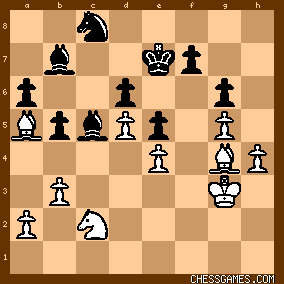
click for larger view52... f6
"It is not easy to sit idly by while one is being slowly strangled. The text move does not improve Black's position, but what move does?" (Euwe) "It is in positions like this that one makes moves that merely serve to precipitate disaster, and indeed this move seriously weakens Black on e6 and g6. But though one can give the text move a query, Black has no other move that will prove satisfactory in the long run." (Golombek) 'This creates one more weakness for Black, in the shape of the g6-pawn. But it was hardly possible to defend Black's position any longer..." (Keres) While I have no great ideas on how Black could have saved the game from here, comparatively best seems to be 52...Ba7. White, as noted by several commentators, would then play 53. Nb4 after which Black would have nothing better than 53...Bb6 54. Nc6+ [the point of Nb4 of course] 54...BxN 55. dxB BxB 56. BxN leaving Bishops of opposite colors, but with 57. Bxa6 to follow Black would seem to have a hard time remaining alive. The text, however, was worse, and left: 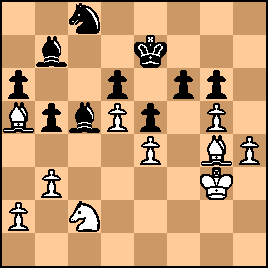
click for larger view53. Be6
This may win, but strongest here, as later pointed out by Euwe, was 53. gxf6+ Kxf6 54. Bd8+. 53... fxg5
Even worse for Black would have been 53...g5 54. exf5 as noted by Kmoch. 54. hxg5

click for larger view"A very difficult position for Black." (Euwe)
"White now threatens 55. b4 followed by Bc7 and Ne1-f3-h4 winning a pawn." (Kmoch) Black is indeed is difficult straits here. But is the game now truly lost after Smyslov's second-best 53rd move. I will discuss in my next post on this game Black's possible defense from here until his extremely weak 55th move after which Smyslov snuffed out all further resistance. |
|
Feb-03-24
 | | KEG: Post XI
54... Nb6
"A final desperate effort." (Kmoch)
"Losing a pawn and so somewhat hastening the end. Still, there is no good move." (Golombek) "Black forces a decision; the text move is going to cost a awn, but it will provide Black with breathing space, albeit artificially and only good for about ten moves. After that, the enemy passed pawn will advance far enough to cut off all supply lines again." (Euwe) "the text-move...loses quickly." (Keres)
Yes indeed, the text leads to big trouble--including the eventual loss of a pawn--for Black. But there is nothing better. If 54...Ke8 White romps with 55. Bc7 [55. Bh3 immediately is arguably even stronger] Ke7 56. Bh3 Nb6 57. b4 Bg1 58. Kg2 wins If instead 54...Ba7 then White wins after 55. Bh3 Bc5 56. Kf3 Nb6 57. b4 Nc4 58. bxB NxB 59. c6 55. b4

click for larger view"!"--(Kmoch)
"In this way White wins a pawn, since 55...Bg1 is not possible on account of 56. Kg2." (Smyslov) 55... Nc4?
Euwe was likely already doomed, but the feeble text pretty much ended his resistance. 55...Bg1, as Golombek pointed out, runs into 56. Kg2 and White wins a piece. The most stingy resistance would probably have been offered by 55...Na4, e.g. 56. bxB Nxc5 57. Kf3 NxB 58. KxN Kxe6 leaving Black with two pawns for the sacrificed piece and perhaps a prayer of counter-play. But I wouldn't want to try to hold that position as Black against Smyslov! 56. bxB NxB
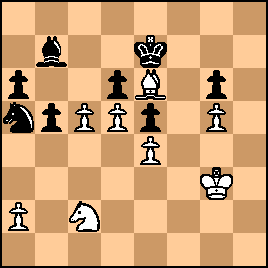
click for larger view57. cxd6+
"Of course not 57. c6 [??--KEG] Bxc6 after which White would have to scramble to hold the draw. Smyslov, needless to say, was not going to fall for any such nonsense. 57... Kxd6
58. Bf7
"!"--(Kmoch)

click for larger view"Now the g6 pawn falls, after which Black's game is lost." (Smyslov) "Now the g6-pawn falls and White's strong passed pawn quickly decides the outcome of the game. The end is no longer interesting." (Keres) 58... Nc4
59. Bxg6 a5
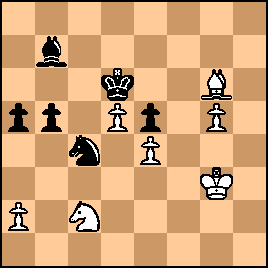
click for larger view"The attempt [by Black--KEG] to get a passed Pawn is of no significance. Smyslov wins easily." (Kmoch) Whilte the game is now a clear win for White, some of us [Keres obviously not amongst us] can enjoy Smyslov's techique in closing out this hard-fought game. |
|
| Feb-03-24 | | RookFile: Super game by Smyslov. Euwe needed to murk things up rather than try for the solid defense. |
|
Feb-03-24
 | | KEG: Post XII
60. Kg4
60. Bf5 is equally decisive.
60... b4
60...Ke7 might have allowed Euwe to prolong the game a bit longer, but passivity was never going to save the day and so the text was probably the best option available. 61. Bf5
"It is strictly logical that the correct method of winning the game consists in the continued nullification of Black's Bishop." (Golombek) There were other winning methods [Golombek notwithstanding, 61. Kf5 also ultimately leads to a win], but the text is the fastest and most pleasing route to victory. It left Euwe in the following unhappy position: 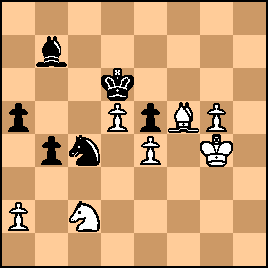
click for larger view61... Ke7
62. Be6 Nd6
As Golombek noted, if either 62...Kf8 or 62...Ba6 White wins with 63. Kf5. 63. Ne3
"!"--(Golombek)(Kmoch)(Keres)(Smyslov)
63. g6 also wins.
The text left:

click for larger view63... Nxe4
This doesn't work, but neither would anything else. If instead 63...a4 White wins (as pointed out by both Golombek and Keres) with 64. Nf5+ NxN 65. exN and now if: (A) 65...b3 then 66. f6+ [the move given by Keres and Golombek, but White wins even more brutally with 66. axb3 after which White Queens first in all variations, e.g. 66...a3 67. f6+ Kd6 68. f7] 66...Kd5 67. f7 wins. (B) 65...a3 66. f6+ Kd6 67. g6
(C) 65...Ba6 66. f5+ Kd6 67. f7 Ke7 68. g6 [or 68. d6+] Alternatively, if 63...Ne8 64. Nf5+
64. Kf5
64. g6 or 64. Nf5+ are perhaps even quicker.
64... Nd6+
65. Kxe5 Nf7+

click for larger view66. Kf4
Crushing, but so was 66. BxN KxB 67. d6 Bc8 68. Nd5 and Black is finished. 66... Nd8
"White threatened 67. Nf5+..." (Golombek)
Black could have struggled on a bit longer perhaps with 66...Nh8 [talk about an ugly move!] or 66...Nxg5 [desperation sac], but neither move would have changes the outcome. 67. Nf5+ Kf8
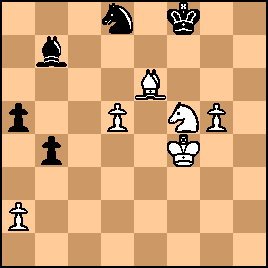
click for larger view |
|
Feb-03-24
 | | KEG: Post XIII
68. g6 NxB+
Desperation!
69. dxN
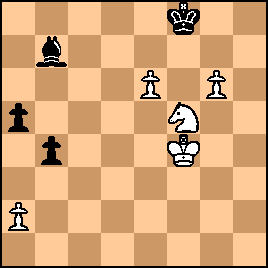
click for larger view69... a4
70. Ke5
"!"--(Smyslov)

click for larger view1-0
<nummerzwei> gives a neat trick Euwe might have tried: e.g. 70...Bc6 71. g7+ Kg8 hoping for 72. Ne7+, but Smyslov would of course have played 72. Kf6--game over. A fine win by Smyslov. |
|
Feb-04-24
 | | nizmo11: <KEG> Another great work!
I would like to ask, if you have seen the book <The Life and Games of Vasily Smyslov, vol I, The Early Years> by <Andrey Terekhov> (Russel Enterprises 2020)?. This is the game 45 in the book, analyzed on pages 459-471. |
|
Feb-05-24
 | | KEG: <nizmo> No, I was not familiar with that book. But given your recommendation, I will promptly get it. Thank you. |
|
Feb-05-24
 | | KEG: I of course meant to respond to <nizmo11> |
|
Feb-05-24
 | | nizmo11: A comment to sacrifice on move 43...
<43...Bxd5! 44. exB Nxd5 45. Be1 (best) Nf4 46. Bc2 d5>

click for larger viewThis -like the whole ending in general - is very difficult to analyze, but I could not find a way for Black to draw here after 47.Ng3 or 47.Bd1,
for example 47 Ng3 Be3+ 48. Kf1 e4 (weakening, but it seems this need to be played eventually) 49.Bd1 Nd3 50.Bc3 Kd6 51.Bf6! Ne5 52.h5!, or
49.Bd1 Kd6 50. Bc3 d4, and now computer shows the idea 51. Ba5 Kd5 (or 51...Ke5 52.Bc7+ Kd5 53.b4!) 53.b4! activating bishop with Bb3, after which the bishop pair is very powerful. |
|
Feb-06-24
 | | KEG: <nizmo11>An interesting line that I did not explore in the depth you have. You make a strong case that my suggested 43...Bxd5 loses, but I remain unsure. After 46...d5 47. Ng3 I do not much fancy your 47...Be3+ which somewhat misplaces the Bishop and prefer 47...Bb2 or perhaps 47...Ne6 or even an immediate 47...e4. I agree that after 47...Bb2 you have pretty much demonstrated a win for Black. On the other hand, your alternative, 47. Bd1 looks very weak, and Black now has good play with 47...e4. As always, your analysis opens new vistas in this terribly difficult ending, and I thank you for this important contribution. |
|
Feb-06-24
 | | nizmo11: I think you are right that after 46...d5 47. Ng3 47...e4 is a better continuation. My idea was 48. Bd1, so move order 47. Bd1 e4 48. Ng3 would also lead to the same position:

click for larger viewBut how to evaluate this? I still think that two pawns are not enough for the piece here, both a6 and f7 are weak. |
|
Feb-06-24
 | | sackman: <KEG> many thanks for the very extensive commentary as well as suggestions. very insightful to have the compilation of the thoughts of all the experts (including the players). And to observe their disagreements... |
|
Feb-07-24
 | | KEG: <sackman> Thank you. So glad you found my posts on this game to be of use and of interest. |
|
Feb-07-24
 | | KEG: <nizmo11> You are surely correct that White is better even after my suggested 43...Bxd5 White is better. Your analysis leaves little doubt of that. But since Black has no great options at this point, and since Black does remain with two strong passed pawns in the center, I still think this was the best practical chance available to Euwe even if White still can be said to have a theoretical win with best play on both sides (a point on which I remain unsure). |
|
Feb-07-24
 | | offramp: Many thanks, KEG. |
|
Feb-07-24
 | | KEG: <offramp> As always, great to hear from you. So glad you like my analysis of this game. I spent the better part of a month trying to fathom this complex endgame. |
|
 |
|
< Earlier Kibitzing · PAGE 2 OF 2 ·
Later Kibitzing> |
|
|
|





